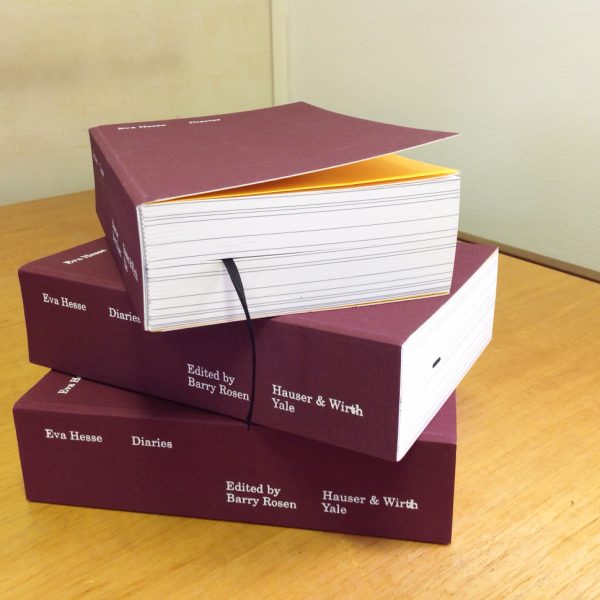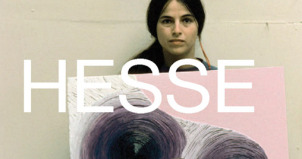Converging Lines: Eva Hesse and Sol LeWitt
 Among our March releases this year is an enchanting book entitled Converging Lines: Eva Hesse and Sol LeWitt, edited by Veronica Roberts and including essays by Lucy R. Lippard, Veronica Roberts, and Kirsten Swenson. The book celebrates the close friendship that Hesse and LeWitt formed between the late 1950s and Hesse’s death in 1970, and sheds light, too, on their close-knit circle of fascinating art world friends including Robert Mangold, Sylvia Plimack Mangold, Robert Ryman, Lucy Lippard, Nancy Holt, Robert Smithson, and others. The book is at once a touching depiction of an admiring and supportive relationship and the first book to look carefully at the artists’ reciprocal influence on each other’s art. The book accompanies an exhibition that will open on February 23rd at the Blanton Museum of Art at the University of Texas at Austin.
Among our March releases this year is an enchanting book entitled Converging Lines: Eva Hesse and Sol LeWitt, edited by Veronica Roberts and including essays by Lucy R. Lippard, Veronica Roberts, and Kirsten Swenson. The book celebrates the close friendship that Hesse and LeWitt formed between the late 1950s and Hesse’s death in 1970, and sheds light, too, on their close-knit circle of fascinating art world friends including Robert Mangold, Sylvia Plimack Mangold, Robert Ryman, Lucy Lippard, Nancy Holt, Robert Smithson, and others. The book is at once a touching depiction of an admiring and supportive relationship and the first book to look carefully at the artists’ reciprocal influence on each other’s art. The book accompanies an exhibition that will open on February 23rd at the Blanton Museum of Art at the University of Texas at Austin.
Here is a sneak peek of some words and images from the book.
In certain respects, the close friendship that developed between Hesse and LeWitt was unlikely. The strategies and processes underlying their respective work appear diametrically opposed. LeWitt’s conceptual approach to making art privileged preset rules and systems and willfully purged subjectivity. In contrast, Hesse arrived at aesthetic decisions more intuitively and with a greater personal investment in her materials and forms. While LeWitt famously declared, “The idea becomes the machine that makes the work” and that “execution is a perfunctory affair,” Hesse accentuated the personal and hand-made qualities of her work.
These sharp differences manifest themselves graphically in their art. LeWitt is best known for neutral geometric shapes and structures produces by scores of assistants and fabricators, while Hesse’s paintings and sculptures are indelibly linked to biomorphic shapes, erotic forms, and irregular edges produced by her own hand. A comparison of LeWitt’s white modular cube (3 x 3 x 3, 1965) with Hesse’s black sausage-shaped sculpture from 1966 epitomizes their differences. LeWitt’s modestly-sized structure, open cubes stacked three squares long, wide, and deep, is a quintessential Minimalist form, devoid of expression and purged of any traces of personal construction. Although elemental in its design, 3 x 3 x 3 nevertheless provides an unexpectedly rich visual experience derived from the constantly shifting perspectives and shadows it offers as the viewer looks into and through the work. In contrast, Hesse’s bulbous sculpture dangling by a thin cord conveys a sense of vulnerability and violence. By the time Hesse made this untitled work in New York, she had become friends with artists Paul Thek, Joe Raffaele, and others who similarly explored Surrealist-inspired fetishistic forms and encouraged this tendency in her work. Over time, generalizations developed about their practices: LeWitt’s work became allied with the mind and concepts, while Hesse’s became inextricably linked to the body and process. Indeed, they are in many ways considered paragons of these opposing categorizations—in LeWitt’s case, as a key practitioner of Minimal and conceptual art, and in Hesse’s case, as a pioneer of Post-Minimalism and a host of other labels applied to her work, ranging from Eccentric Abstraction to Anti-Form.
In the early years of their friendship, Hesse and LeWitt’s close rapport was more apparent in their extensive correspondence than in the works of art they produced. Shortly after arriving in Germany for a fifteen-month residency with her husband, Tom Doyle, where the couple worked side by side in an abandoned textile factory, she wrote to LeWitt. Beset by doubts about the first sculptural relief she had begun making there and eager for his perspective, she explained, “We strike some diametrically opposed balance, reacting emotionally so differently, yet somewhere understanding.” On April 14, 1965, LeWitt responded to her apprehensions with an extraordinary five-page letter filled with words of encouragement both poetic and humorous. On the first page, he implored his friend:
Just stop thinking, worrying, looking over your shoulder, wondering, doubting, fearing, hurting, hoping for some easy way out, struggling, grasping, confusing, itching, scratching, mumbling, bumbling, grumbling, humbling, stumbling, rumbling, rambling, mumbling, gambling, tumbling, scumbling, scrambling, hitching, hatching, bitching, moaning, groaning, honing, boning, horse-shitting, hair-splitting, nit-picking, piss-trickling, nose-sticking, ass-gouging, eyeball-poking, finger pointing, alleyway-sneaking, long waiting, small stepping, evil-eyeing, back scratching, searching, perching, besmirching, grinding, grinding away at yourself. Stop it and just DO.
A few pages later, he reiterated his faith in her:
I have much confidence in you and even though you are tormenting yourself, the work you do is very good. Try to do some BAD work. Then you can think of and see what happens, but mainly relax and let everything go to hell. You are not responsible for the world—you are only responsible for your work—so DO IT.
The length of the letter and care LeWitt put into it are testaments to the generous nature of his support and affection for her. Its chain of rhyming verbs and his repeated appeal to her that she just “DO” (which he wrote in large, often embellished script) also signals a love of language—an area of mutual fascination for Hesse and LeWitt that they explored simultaneously in their personal correspondence and art.
Here, in a five-frame slideshow, is a reproduction of the letter itself that LeWitt sent to Hesse in 1965.
Sol LeWitt Letter to Eva Hesse, April 14, 1965 Ink on paper, five pages LeWitt Collection, Chester, Connecticut”
























